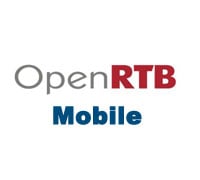 A collection of advertising technology companies have formed the mobile OpenRTB mobile committee which includes Nexage, PubMatic, Smaato, DataXu, Fluent Mobile, [x+1], and Jumptap. According to a release, “The group’s mission is to establish guidelines that enable technology platforms to build standard real-time bidding APIs with basic commonalities that increase the efficiency and speed of adoption and ease interaction between platforms.” Read the release. And, see the Open RTB Mobile site.
A collection of advertising technology companies have formed the mobile OpenRTB mobile committee which includes Nexage, PubMatic, Smaato, DataXu, Fluent Mobile, [x+1], and Jumptap. According to a release, “The group’s mission is to establish guidelines that enable technology platforms to build standard real-time bidding APIs with basic commonalities that increase the efficiency and speed of adoption and ease interaction between platforms.” Read the release. And, see the Open RTB Mobile site.
Nexage CTO Jim Butler discussed the new consortium.
AdExchanger.com: Why is it necessary to have a separate OpenRTB group for Mobile? Why not add on top the existing OpenRTB framework announced in January for display?
JB: We did, in fact, build off of the OpenRTB project. The work that they’ve published for synchronizing block lists and standardizing certain attribute values is applicable to both online and mobile, and OpenRTB Mobile is adopting those standards.
However, a separate mobile group was necessary for the same reason that there are supply-side platforms, demand-side platforms, ad networks, agencies, and development shops that specialize in mobile… There are complexities and characteristics of mobile ad-serving that don’t sync seamlessly with online, and we didn’t want to retrofit standards across the two mediums. For example, the standards addressed by the mobile committee on data representation and establishing a protocol between buyer and seller platforms has already been addressed by the online community; it no longer affects their development, but it is a major roadblock to the development and adoption of real-time bidding technologies in mobile advertising. To address the challenges specific to each medium, we felt that it was necessary to focus our efforts separately, in order to move the entire industry forward.
Insofar as media working cross-channel, from the media buyers and sellers perspective, RTB is evolving into a more streamlined buying process, where online buyers can access mobile inventory and vice versa, which is why the OpenRTB Mobile committee has representatives from both mediums. But the mechanics of ad-serving are still decidedly distinct and standards, like those set forth by OpenRTB Mobile, are necessary to align mobile and online participants on basic functionality and protocols.
Please provide specific examples of what attributes the Mobile group is looking to standardize.
First and foremost is the full real-time bidding interface between exchange and bidders (i.e., sellers and buyers). This includes the communication transport, the data representation, the actual conversation or protocol between the parties, the set of business attributes on which buying decisions are made, and a method of attribute extensibility. As part of this, we’ve standardized specific methods of serving the winning ad, a macro driven approach of communicating information to winning bidders either directly or via the ad markup itself.
Future versions of the specification will address the standardization of device information, carriers, and mobile app characteristics; we’ve also identified business attributes for which we could adopt standards from the online OpenRTB project, like content categories and creative characteristics.
Is real-time bidding at scale possible today via mobile-enabled demand-side platform with features such as global frequency capping? If not today, when? What are the barriers?
RTB in mobile will scale very soon. All of the elements are quickly coming together to make this the breakout year of RTB in mobile: mobile exchanges are gaining momentum, online and mobile DSPs are lining up to integrate to them, and dollar flows through real-time bidding-enabled platforms in online is outpacing even the most bullish expectations, which bodes very well for its future in mobile.
The Mobile RTB Interface specification just ratified by the OpenRTB Mobile includes support for advanced features including bidding on multiple impressions presented as page bundles and support for multiple bidder seats, which enables a number of complex auction rules. The specific feature of global frequency capping is actually not an RTB challenge as much as it is one of unique user identification, which has been and continues to be fundamentally different in the mobile ecosystem than in online. Several companies, including Nexage, have developed methods for identifying unique users across mobile web and application traffic, and are enabling frequency capping on their ad inventory for buyers across standard and RTB-enabled ad-serving.
By John Ebbert











